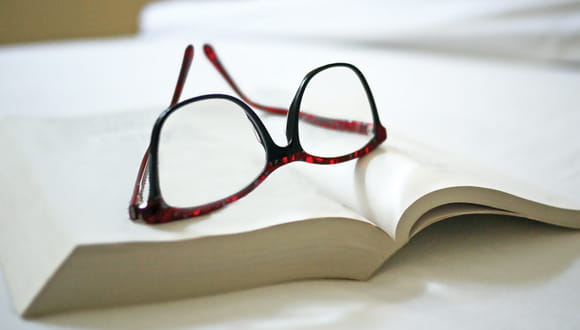If your reading vision has gotten worse with age, you're not alone. Estimates suggest that half of adults have presbyopia, the medical term for the progressive, age-related loss of near vision.
You likely first noticed the changes while reading small print. Perhaps you responded counterintuitively and held the subject matter farther away, where those blurry letters became clearer.
Such recurring near-vision issues have led many adults to settle on reading glasses as an acceptable long-term solution.
But could new eye drops change your calculation?
The FDA recently approved pilocarpine hydrochloride (1.25%) ophthalmic solution, prescription eye drops to help treat presbyopia.
"Pilocarpine is the first drop that's been approved along the spectrum of drops that will eventually be available for improving near vision," says Dr. Rahul Pandit, an ophthalmologist at Houston Methodist. "However, there are definitely pros and cons to consider before using this new drop."
Sure, it would be great to get rid of your reading glasses for once. But how do you know if these new drops are actually right for you?
What is presbyopia?
"When you hit 40 to 45 and beyond, you start developing presbyopia, which is near vision loss that results from age-related stiffening of the lens of your eye," says Dr. Pandit. "Some ophthalmologists refer to this as dysfunctional lens syndrome."
Dr. Pandit adds that this natural lens stiffening is the same process that leads to cataract formation later in life, when stiffening worsens and the lens further hardens and becomes less translucent.
The lens of the eye is meant to be flexible, changing shape depending on whether you're trying to focus on an object that's distant or close.
When you look at an object that's far away, the lens is relaxed. When you focus on an object that's nearby, it changes its shape and curvature. This is called accommodation, during which the pupil also constricts, becoming smaller, which enhances the near-focusing ability of the lens.
"As the lens stiffens over time, it loses its ability to change shape, and as a result you have progressive difficulty with near vision," explains Dr. Pandit.
Reading glasses correct for the limitation by introducing an external lens shaped for focusing on nearby objects, relaying an already-focused image back toward your eye.
One issue, though, is that reading glasses affect distance vision, too. It's why you take them off when you're not focusing on something in close range — one reason reading glasses are easy to lose.
How do the new eye drops for presbyopia work?
Pilocarpine is a medication that improves close-range vision by constricting your pupil.
Dr. Pandit adds that it's important to note that the drops don't change the shape of the natural lens of your eye or make it more flexible. Instead, they mimic what naturally happens to your pupil when you are accommodating.
"Pilocarpine isn't a new medication," says Dr. Pandit. "We've been using it to treat glaucoma for decades. It's also what we use when we need to constrict the pupil for certain eye procedures."
The only difference with these new drops, he explains, is that a newer formulation is used and the chemical nature of the solution has been changed so it's absorbed in a gentler way and works for a more defined period of time.
The daily drops, available by prescription only, take effect in as little as 15 minutes and work for up to six hours.
The benefit of improving near vision in this way is that, unlike reading glasses, the pilocarpine drops aren't supposed to affect your distance vision.
What are the side effects of using pilocarpine eye drops to correct close-range vision?
"What does constriction of the pupil do?" asks Dr. Pandit. "It keeps your eye muscles active and closes off some of your peripheral vision, so eye strain and tunnel vision may result for some people."
The most common side effects reported while using pilocarpine (1.25%) prescription eye drops are:
- Headaches
- Eye redness
- Eye irritation
- Increased tear production
The drops may also impair your vision in low-light situations, so they're not recommended for night driving.
"There will eventually be other drops available for improving near vision that work in slightly different ways or with slightly different formulations, which may help overcome some of the unwanted side effects of the pilocarpine drops," Dr. Pandit adds.
Are there other ways to improve close-range vision?
As Dr. Pandit points out, reading glasses and these new eye drops aren't the only presbyopia treatment options to consider.
Other alternatives for improving near vision, some of which are permanent, include:
- Bifocal and monovision contact lenses
- Monovision laser surgery
- Lens implants
"There are many different ways to correct near vision, but no perfect way to reproduce the natural ability to focus of our youth," says Dr. Pandit. "It's important to speak to an ophthalmologist if you're interested in getting a comprehensive overview of the options. Consulting your doctor can also help ensure you find the treatment that makes the most sense for you based the severity of your presbyopia and unique lifestyle needs."


